As usual, when my key race looms in the not so distant future, I begin thinking about all those necessary requirements needed to get from start to finish that should have been thought about at the beginning of training, when there was time to experiment. You would think after so many marathons and other races, I would have nutrition, training, and strategies all worked out. That’s not the case since needs change and strategies are adjusted to work towards optimal performance. The bottom line here is that nutritional needs vary from person to person, situation to situation, race season to race season.
I have been a long time advocate for reduced carbohydrate fuel in training, teaching my body to burn more fat so that on race day, it will utilize the carbohydrates in a more expeditious manner. After reading quite a number of articles lately, this belief may be all wrong.
Here is an excerpt from an interview with the 2015 Lake Sonoma 50 Mile Women’s Champion, Stephanie Howe who has a background in nutrition. Interviewed by iRunFar (SOURCE).
iRunFar: … Did your stomach ever go at all?
Howe: … No…. I just took three gels an hour – constant fuel. Clif Shot gels, mixing up the flavors…
iRunFar: That’s interesting because these days there’s sort of a branch of ultrarunners who race with gels or nutrition products but they definitely train very low or not at all. With your background in nutrition, what’s your take on that?
Howe: The science behind that is not very good – that training without carbohydrate The thought behind it is that it produces more stress on the body so you adapt. While that may be true, you aren’t as used to processing carbohydrates. You have less ability. You down-regulate your receptors. If you don’t need them, your body is not going to use the extra energy to keep them. When you get into a race situation and you’re trying to take in carbohydrate, you just can’t use it as well….
In review of fuel intake and racing, the body needs two basic sources: carbohydrates and fats. The greater the intensity, as during a race situation, the more carbs are burned relative to fat since carbohydrates are the quicker source for the body to grab and use. Fats are used at lower intensity and need more “processing” than carbs. The amount of carbohydrates during a race (or training) depends on the level of intensity and the amount of time you have to maintain that intensity.
Keep in mind, that if you use gels or other carb sources in training too much, you won’t teach your body to utilize fat for energy. It will constantly look for quick fuel. Aerobic conditioning, which is done as base training at the beginning of an endurance training program, will condition your body to burn more fat. This is when you don’t need to constantly replenish fuel stores with gels. If training for 90 minutes or less, try to simply eat a 200 calorie meal of mainly carbs with a little protein an hour and half to two hours before training. For 2 hours or more, practice taking in carbohydrates.
Remember: The earlier in the race or in that intense training situation, you take in the carbs, the easier time your body will have digesting them. As the duration of intensity continues, your body cannot absorb the fuel as easily nor as quickly. This is when the test of endurance goes from the physical strength to the mental stamina.
Depending on the person, a good schedule during a marathon or distance event might be as follows: *Water should be taken whenever taking in gels or solid food.
**No more than 200 to 300 calories per hour, depending on body size and intensity. For women smaller in stature, 1/2 a gel might suffice, taken more frequently since 1 gel is a lot to digest.
1/2 to 1 gel after 4 miles or after 30 minutes of the start of the race.
1/2 to 1 gel after another 5 to 6 miles or after another 45 to 50 minutes after the last intake of fuel.
1/2 to 1 gel after another 6 miles or 60 minutes.
Continue taking in fuel as required. SOURCE
One last point: Caffeine. Once again, this is a personal preference. I’m a super coffee fanatic. Love my coffee!…only not on race day. What I do like is 5-Hour Energy which has a good shot of caffeine (they also offer it in DECAF) in it BUT, I have to take this drink at least an hour before the race start because it makes me run for the porto-potty line. It’s a good way to get things “moving” before hitting the starting line.
What are your fueling strategies when you put out a lot of intensity in racing or training?
Have you modified that strategy over the years?
Energy Bar Recipe from 2010
I made this recipe when the CEimB group was still active. It’s a tasty little bar and easy to eat for early morning workouts/running.
Puree the dried apricots makes them about flavor and nutrition and less about texture.
Ingredients
- Cooking spray
- 1 cup quick cooking rolled oats
- 1/2 cup raw unsalted sunflower seeds
- 1/2 cup toasted raw pumpkin seeds
- 1/4 cup whole-wheat flour
- 1/2 cup dried apricots – pureed in food processor
- 1/2 cup raw almonds
- 1/2 cup dried unsweetened tart cherries
- 1/2 cup pitted dried dates
- 1/2 cup powdered nonfat dry milk (here’s your protein!)
- 1/2 teaspoon ground cinnamon
- 1/3 cup pure maple syrup
- 2 large eggs
Directions
Preheat the oven to 350 degrees F. Coat a 9 by 13-inch baking pan with cooking spray.
Place all ingredients except the syrup and eggs in a food processor and pulse until the mixture is finely chopped. Add the syrup and eggs and pulse until the mixture is well combined. It will resemble a coarse paste.
Transfer to the baking pan and spread evenly. Bake until just done, about 15 -18 minutes.
Have you made an energy bar? What’s your favorite recipe?

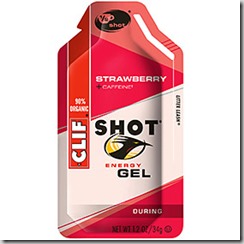
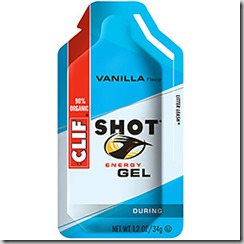
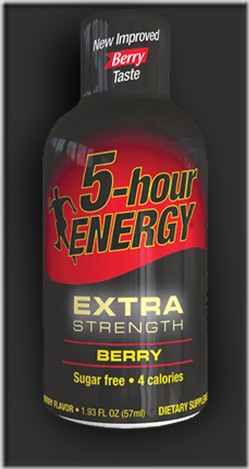
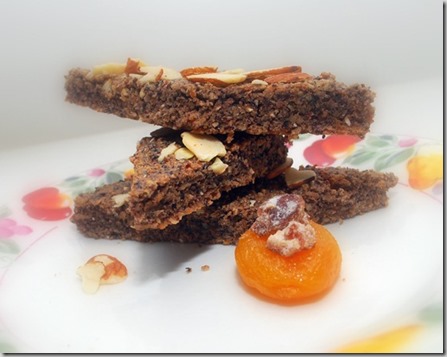

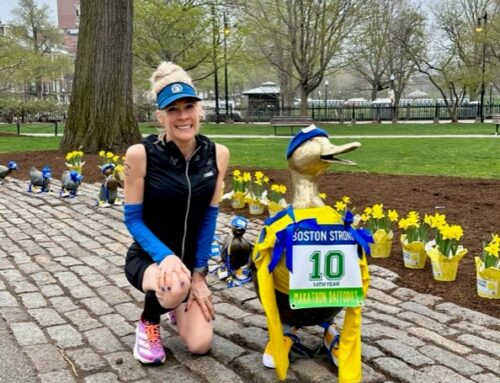
Very interesting comments from the ultra runner. I think everyone has to play around and figure out what works best for them. I have friends who can start taking gels at mile 3 in a marathon and others who only take one around mile 22. I am trying to tap into what my body tells me. At Sunday’s 10-miler, I brought a gel along to use only if I felt like I needed it. Around mile 7.5, I felt like my legs were getting tired so I took one and by mile 8 or so, I felt much improved. I only wish it was so easy for a marathon!
Best of luck on Monday!